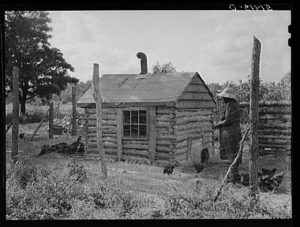By Robin Mayes, Farm Educator

Today, when we hear someone mention the three R’s they usually aren’t talking about “readin’, ‘ritin’, and ‘rithmetic. Instead, they are most likely encouraging others to “reduce, reuse and recycle.” Making a conscience effort to help preserve the environment has become commonplace in most households. These efforts have gained momentum in recent decades but are not actually new.
The Great Depression taught our grandparents the importance of keeping items they might need again and reusing items that still work. They also became adept at altering found items for a new purpose.
Framed needlework, emblazoned with the words “Waste Not, Want Not,” graced the walls of many homes. “Use it up, wear it out, make it do, or do without” was another well-used adage of the time.
One of my favorite images from the collection of Depression-era photos on the Library of Congress site is that of a rather snug-looking chicken coop. Although it looks to be made of old fenceposts and the roof is just covered with tarpaper, it has a glass-paned window. The caption under the picture reads:
“Pauline Clyburn, rehabilitation client at Manning, Clarendon County, South Carolina, with chicken house she made herself. The window she took from her own bedroom.”
During the Depression years, whole shanty-towns sprung up on the edges of cities made entirely of found materials. Many homeless persons made what little money they could by creating “Tramp Art” and selling the pieces to those who were a little better off. Items as humble as used matchsticks were saved and combined to make small boxes and decorative pieces. Discarded cigar boxes and parts of wooden crates were whittled and layered to create beautiful keepsakes.
Visitors to Gallant Farm often ask the location of the trashcan in the farmhouse. They are surprised to learn that in the not-so-distant-past, trash receptacles were not nearly as necessary as today. Purchased items were not yet wrapped in plastic. Most things came in paper which was re-used or utilized to start the fir
e in the cook stove or light the pilot of a gas range. Larger items came in wooden boxes that were often used for storage or rebuilt into other objects. Even the tin cans of some purchased food items, were washed and saved for use as scoops, to carry nails in, or snipped into more of that popular Tramp Art. At the very least, the lid and/or the flattened can could be put into service to patch a hole. The cotton sacks that contained flour, meal and animal feed were turned into household linens and clothing.
Recycling, reusing, or even upcycling only makes sense in keeping useable items from ending up in our ever-expanding landfills. It doesn’t take much imagination to foresee us all eventually buried in our own trash on a treeless landscape.
Almost every item of food we buy is ensconced in an outer-wrap of cellophane and then in a brightly-colored cardboard box with yet another bag inside. Even with recycling efforts, most households place at least one Volkswagon-sized plastic receptacle of land-fill fodder on the curb each and every week.
I have always been intrigued by the Moundbuilder cultures who inhabited this continent many centuries past. Archaeologists have been digging into those mounds for a couple of hundred years – trying to unlock the secrets of those ancient civilizations. I like to imagine future archaeologists, hundreds or thousands of years from now, digging in to the giant present day “mounds” south of the city of Columbus. What would they deduce from the remains of our “civilization?”
Come to Gallant Farm on May 12 at 10:00 a.m. for our Waste Not, Want Not program and take a historical look at the thriftiness and frugality of past generations with tips we can use today. Just as wooden crates were salvaged in the past, we will use today’s equivalent, the wooden pallet, to create something new.






